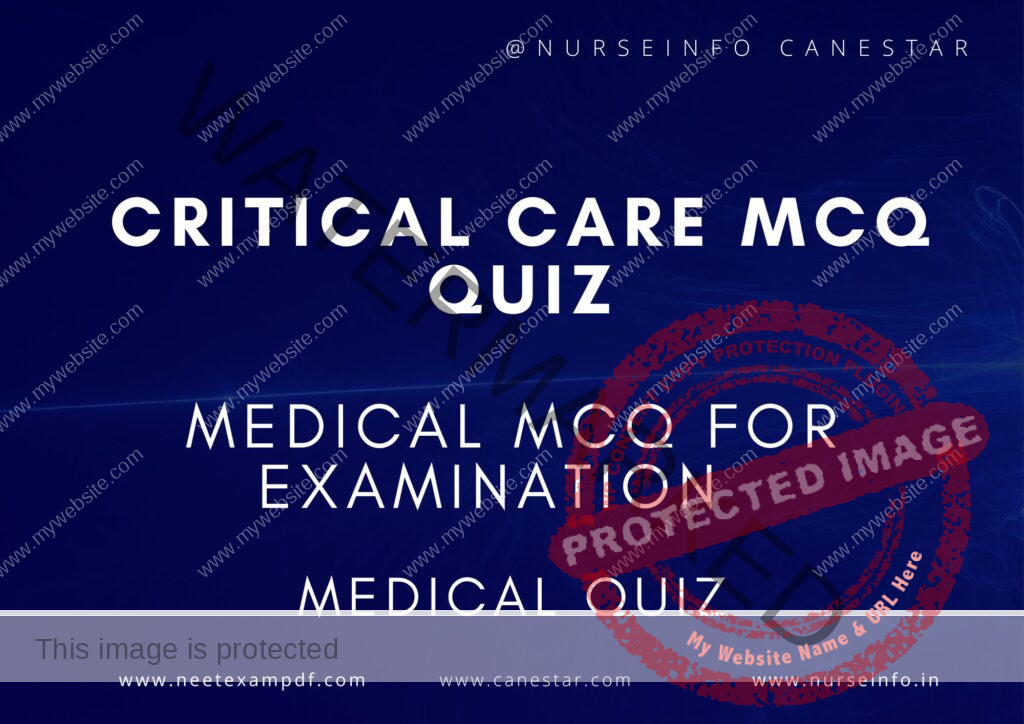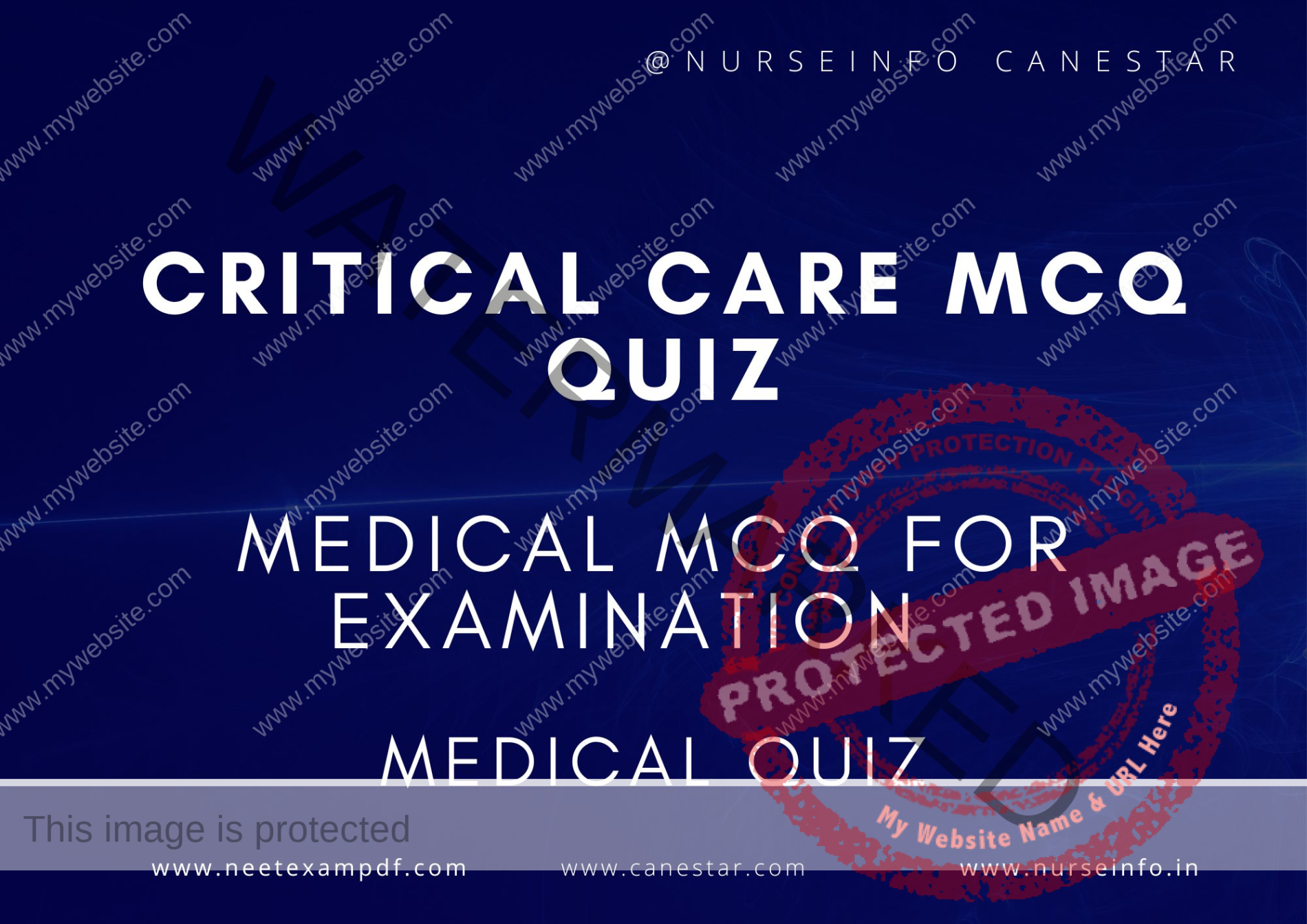MULTIPLE CHOICE QUESTIONS ON CRITICAL CARE MCQ QUIZ – MCQS WITH RATIONALE ANSWER – CRITICAL CARE ICU MCQ QUESTIONS WITH RATIONALE
MCQ FOR CRITICAL CARE QUIZ
These mcqs are prepared exclusively for medical professionals for exam preparation. MCQ is helpful to remember the concept on critical care icu mcq quiz. This multiple choice questions are helpful for preparation for DHA, PROMETRIC, MOH, HAAD, NCLEX, Medical, NEET and Nursing EXAMINATION
CRITICAL CARE ICU MCQ QUIZ
Critical Care MCQs with Rationale
1. Which of the following is the most reliable indicator of adequate tissue perfusion in a critically ill patient?
A. Blood pressure
B. Heart rate
C. Urine output
D. Central venous pressure
Answer: C. Urine output
Rationale: Urine output is a direct indicator of kidney function and perfusion. Adequate urine output suggests that the kidneys are receiving enough blood flow, which is a good indicator of overall tissue perfusion.
2. A patient with acute respiratory distress syndrome (ARDS) is placed on mechanical ventilation. Which of the following ventilator settings is most appropriate to prevent ventilator-induced lung injury?
A. High tidal volume, low PEEP
B. Low tidal volume, high PEEP
C. High tidal volume, high PEEP
D. Low tidal volume, low PEEP
Answer: B. Low tidal volume, high PEEP
Rationale: Low tidal volumes reduce the risk of barotrauma and volutrauma, while high PEEP helps to keep the alveoli open, improving oxygenation and preventing atelectasis in ARDS patients.
3. Which of the following is the most common cause of sepsis in critically ill patients?
A. Viral infection
B. Fungal infection
C. Bacterial infection
D. Parasitic infection
Answer: C. Bacterial infection
Rationale: Bacterial infections are the most common cause of sepsis, which can lead to systemic inflammatory response syndrome (SIRS) and septic shock if not promptly treated.
4. In the management of septic shock, which of the following interventions should be initiated first?
A. Administer broad-spectrum antibiotics
B. Administer intravenous fluids
C. Administer vasopressors
D. Obtain blood cultures
Answer: B. Administer intravenous fluids
Rationale: Initial fluid resuscitation is crucial in managing septic shock to restore intravascular volume and improve tissue perfusion. Broad-spectrum antibiotics and blood cultures should follow promptly.
5. Which of the following is an early sign of increased intracranial pressure (ICP)?
A. Bradycardia
B. Hypertension
C. Altered level of consciousness
D. Irregular breathing
Answer: C. Altered level of consciousness
Rationale: An altered level of consciousness is an early sign of increased ICP, often preceding other signs such as bradycardia and hypertension, which are part of Cushing’s triad.
6. The preferred position for a patient with increased intracranial pressure (ICP) is:
A. Supine
B. Trendelenburg
C. High Fowler’s
D. Head of bed elevated 30 degrees
Answer: D. Head of bed elevated 30 degrees
Rationale: Elevating the head of the bed helps to decrease ICP by promoting venous drainage from the brain and reducing cerebral edema.
7. Which of the following is a common complication of prolonged mechanical ventilation?
A. Pulmonary embolism
B. Acute renal failure
C. Ventilator-associated pneumonia
D. Myocardial infarction
Answer: C. Ventilator-associated pneumonia
Rationale: Ventilator-associated pneumonia (VAP) is a common and serious complication of prolonged mechanical ventilation due to the invasive nature of intubation and the potential for microbial colonization.
8. A patient in the ICU develops a new onset of confusion and agitation. Which of the following is the most likely cause?
A. Hyperglycemia
B. Hypoglycemia
C. Hypernatremia
D. Hypoxia
Answer: D. Hypoxia
Rationale: Hypoxia is a common cause of confusion and agitation in critically ill patients and should be ruled out promptly as it requires immediate intervention.
9. In the management of acute myocardial infarction (AMI), which medication is typically administered first?
A. Beta-blocker
B. ACE inhibitor
C. Nitroglycerin
D. Aspirin
Answer: D. Aspirin
Rationale: Aspirin is administered first because it inhibits platelet aggregation, reducing the risk of clot expansion and further myocardial damage.
10. Which of the following electrolyte imbalances is most likely to cause cardiac arrhythmias in a critically ill patient?
A. Hypocalcemia
B. Hypermagnesemia
C. Hypokalemia
D. Hyperchloremia
Answer: C. Hypokalemia
Rationale: Hypokalemia can cause significant cardiac arrhythmias, including ventricular tachycardia and fibrillation, due to its effects on cardiac electrical activity.
11. Which of the following is the primary goal in the management of a patient with acute pancreatitis in the ICU?
A. Control of blood glucose levels
B. Aggressive hydration
C. Administration of antibiotics
D. Initiation of enteral feeding
Answer: B. Aggressive hydration
Rationale: Aggressive hydration is crucial in the management of acute pancreatitis to maintain adequate intravascular volume and perfusion to the pancreas and other organs.
12. The primary treatment for a patient with neurogenic shock is:
A. Fluid resuscitation
B. Administration of vasopressors
C. Administration of corticosteroids
D. Elevation of the legs
Answer: A. Fluid resuscitation
Rationale: Fluid resuscitation is the initial treatment to restore intravascular volume. Vasopressors may be added if hypotension persists despite adequate fluid resuscitation.
13. Which of the following is the best indicator of effective chest compressions during CPR?
A. Capillary refill time
B. End-tidal CO2 levels
C. Blood pressure readings
D. Heart rate monitoring
Answer: B. End-tidal CO2 levels
Rationale: End-tidal CO2 levels provide real-time feedback on the effectiveness of chest compressions, with higher levels indicating better perfusion and CO2 exchange.
14. In managing a patient with acute pulmonary edema, which of the following medications is typically administered first?
A. Beta-blockers
B. Diuretics
C. ACE inhibitors
D. Anticoagulants
Answer: B. Diuretics
Rationale: Diuretics, such as furosemide, are administered to reduce fluid overload and alleviate symptoms of pulmonary edema by promoting diuresis.
15. Which of the following is a common side effect of prolonged use of corticosteroids in critically ill patients?
A. Hyperkalemia
B. Hypoglycemia
C. Immunosuppression
D. Bradycardia
Answer: C. Immunosuppression
Rationale: Prolonged corticosteroid use can lead to immunosuppression, increasing the risk of infections in critically ill patients.
16. In the context of critical care, what does the acronym FAST stand for in the assessment of trauma patients?
A. Focused Abdominal Sonography for Trauma
B. Focused Assessment with Sonography for Trauma
C. First Aid Sonography Technique
D. Focused Assessment with Scintigraphy for Trauma
Answer: B. Focused Assessment with Sonography for Trauma
Rationale: FAST stands for Focused Assessment with Sonography for Trauma, a rapid bedside ultrasound examination used to detect free fluid (usually blood) in the peritoneal, pleural, and pericardial spaces.
17. Which of the following is an early sign of hypovolemic shock?
A. Bradycardia
B. Hypotension
C. Tachycardia
D. Cyanosis
Answer: C. Tachycardia
Rationale: Tachycardia is an early compensatory mechanism in hypovolemic shock to maintain cardiac output and tissue perfusion despite reduced blood volume.
18. What is the primary cause of acute respiratory distress syndrome (ARDS)?
A. Sepsis
B. Pulmonary embolism
C. Myocardial infarction
D. Chronic obstructive pulmonary disease (COPD)
Answer: A. Sepsis
Rationale: Sepsis is a leading cause of ARDS due to the systemic inflammatory response that results in increased capillary permeability and non-cardiogenic pulmonary edema.
19. In a patient with suspected acute coronary syndrome (ACS), which biomarker is most specific for myocardial injury?
A. Myoglobin
B. Creatine kinase-MB (CK-MB)
C. Troponin
D. Lactate dehydrogenase (LDH)
Answer: C. Troponin
Rationale: Troponin is the most specific and sensitive biomarker for myocardial injury, providing valuable diagnostic and prognostic information in ACS.
20. Which of the following is the most appropriate initial step in the management of a patient with anaphylactic shock?
A. Administer intravenous fluids
B. Administer corticosteroids
C. Administer epinephrine
D. Administer antihistamines
Answer: C. Administer epinephrine
Rationale: Epinephrine is the first-line treatment for anaphylactic shock as it counteracts the severe allergic reaction by reversing vasodilation and bronchoconstriction.


